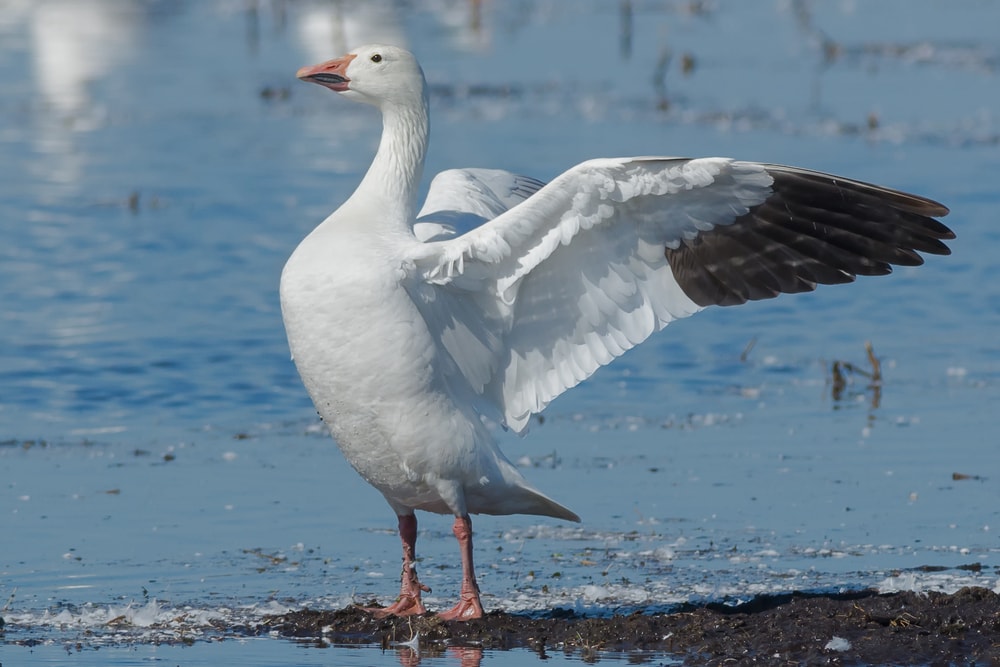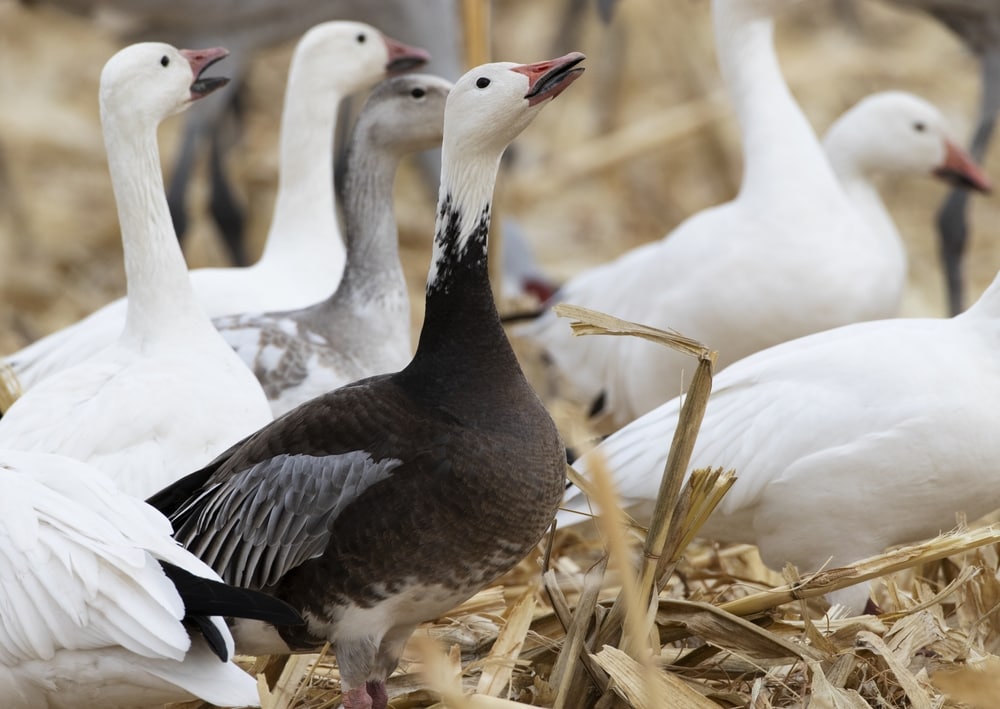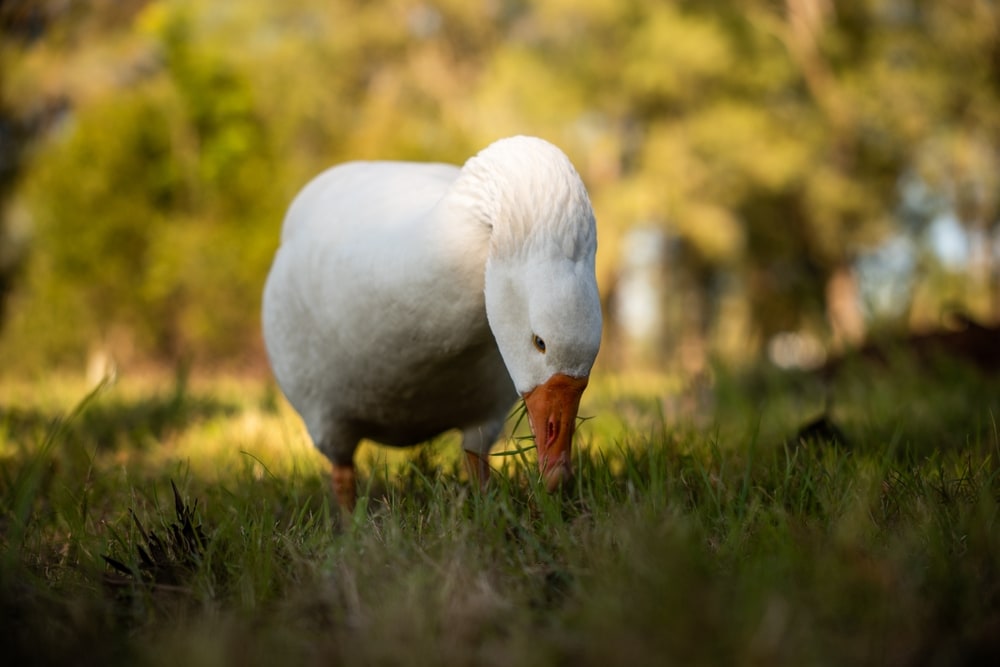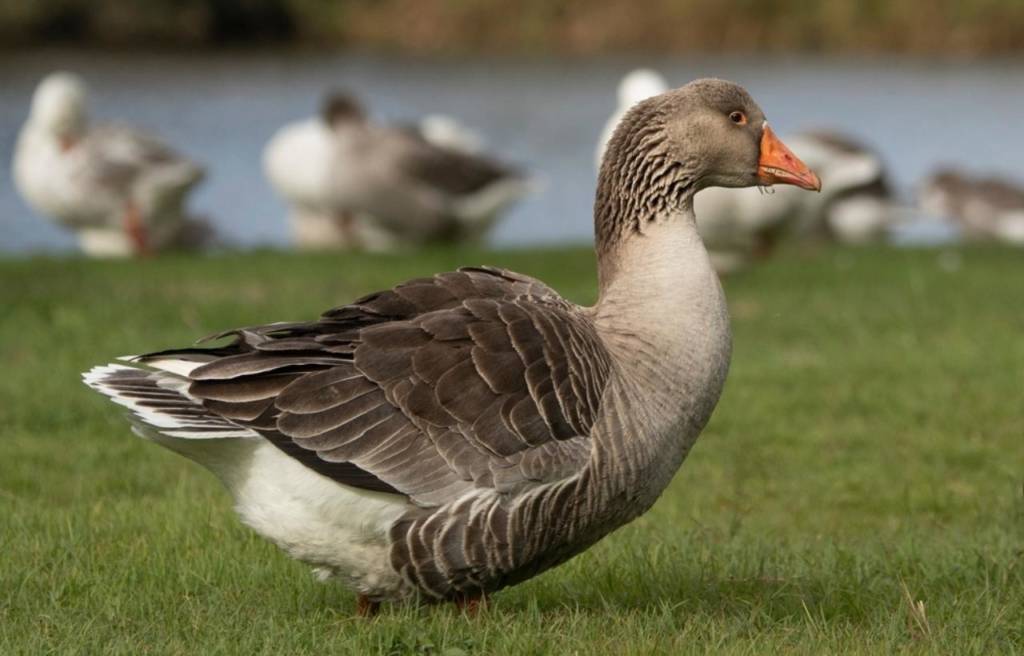Outforia Quicktake: Key Takeaways
- Geese have a long lineage, dating back over 7,000 years, with new species developing from domestic and wild sources.
- Geese species include the Canada Goose, Cackling Goose, Snow Goose, Ross’s Goose, and Barnacle Goose, among many others.
- Geese have various unique qualities, such as the Barnacle Goose’s unique breeding behavior and the Emperor Goose’s striking plumage.
- Domestic geese species are often bred for meat, eggs, and feathers, while wild geese species have interesting migration patterns and behaviors.
- Conservation efforts are essential for some geese species, such as the critically endangered American Buff Goose and the vulnerable Red-breasted Goose.
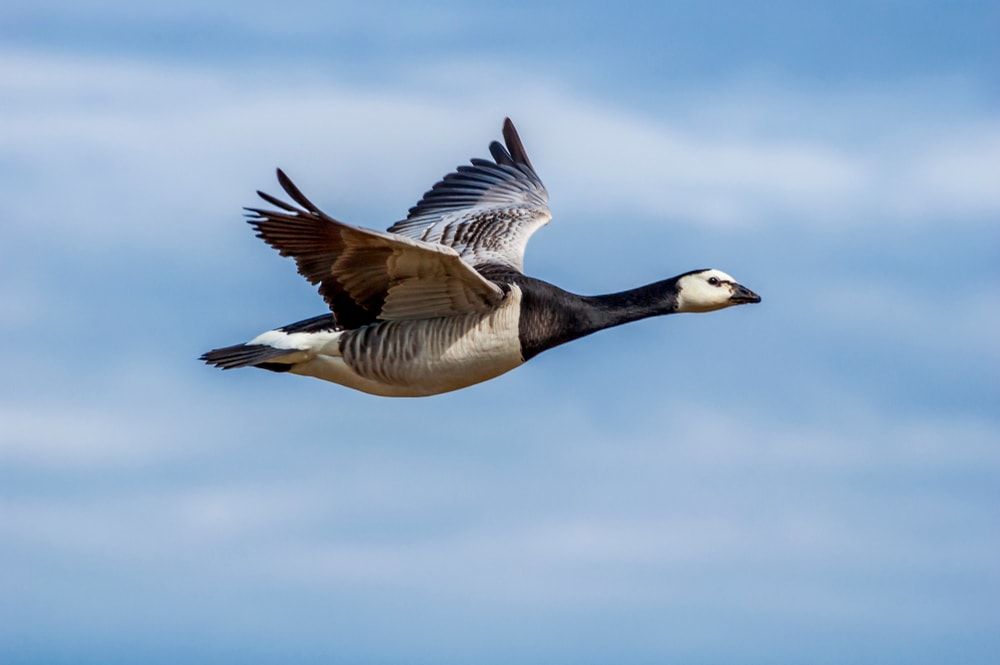
Did you know evidence of domestic geese dates back over 7,000 years ago? This led scientists to believe geese may have been the first domesticated animal.
Due to their long lineage, new species have developed from domestic and wild sources. Back then, breeders worked on developing new species for meat and egg production. This was until chicken domestication became widespread.
This all happened while ornithologists continued to discover new species of wild geese.
The list below will go over both wild and domestic species of geese. Read on to learn about the many links between species and their unique qualities!
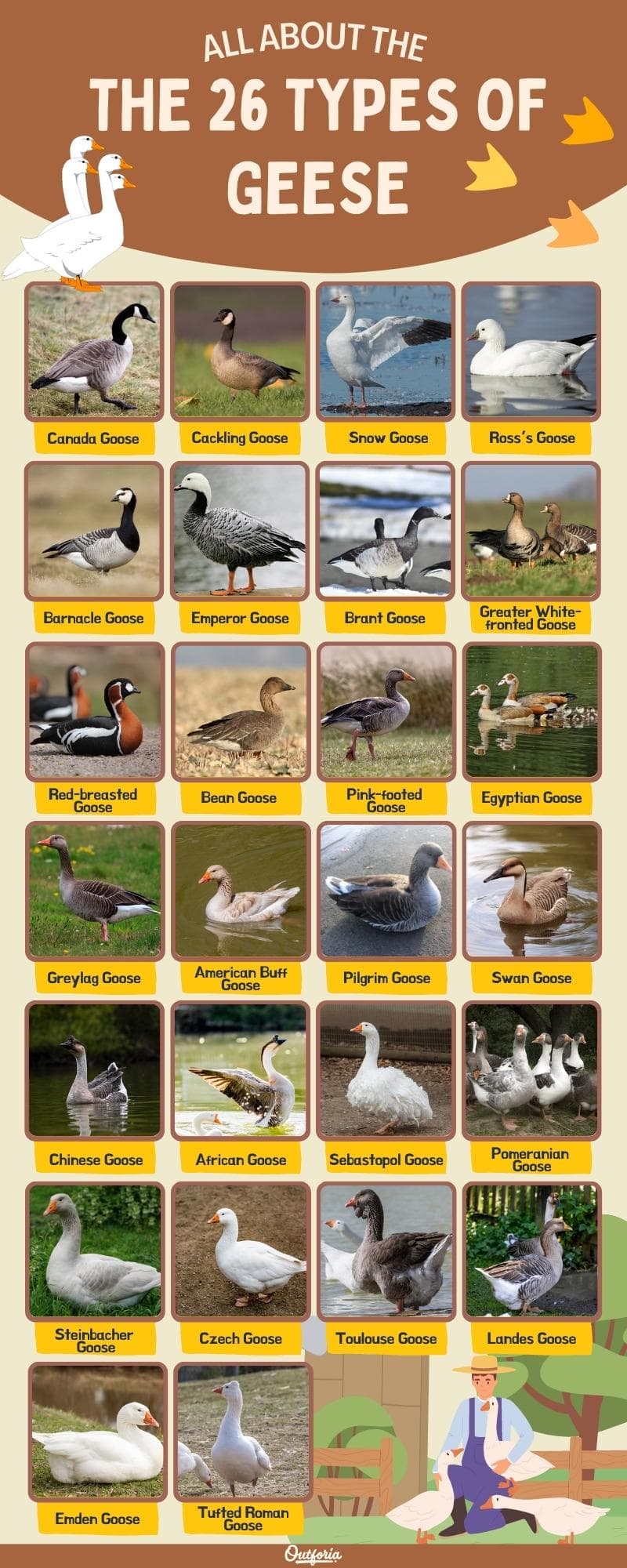
SHARE THIS IMAGE ON YOUR SITE
<a href="https://outforia.com/types-of-geese/"><img style="width:100%;" src="https://outforia.com/wp-content/uploads/2022/08/TYPES-OF-GEESE-INFOGRAPHIC.jpg"></a><br>TYPES OF GEESE <a href="https://outforia.com">Outforia</a>1. Canada Goose (Branta canadensis)
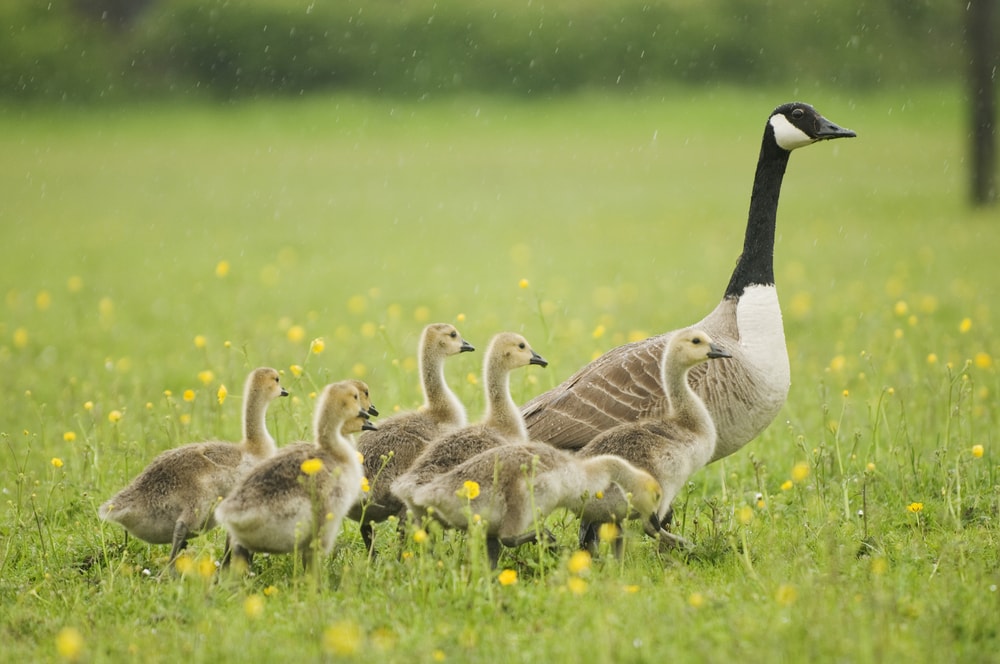
North America’s most abundant and recognizable waterfowl is the Canada goose. These wild geese weigh between 5 and 20 pounds (2.3 and 9.1 kg). They bear a wingspan between 50 and 69 inches (127 and 175.3 centimeters).
These geese breed all across North America. They tend to establish themselves on large lakes to small ponds.
If breeding grounds are disturbed, they begin their classic honking and hissing. If the threat continues, the Canada goose will try to bite or beat intruders with their wings.
Canada geese goslings are among the most intelligent of any bird species. The young intently follow their parents and learn to swim and dive within 24 hours of hatching. Goslings stay with their parents for a year, learning to feed and fly within a few months.
Their impressionability leads them astray from time to time. It isn’t uncommon for goslings to get separated. They sometimes end up following other waterfowl species. In turn, they will end up learning the behaviors of their “new mother”.
2. Cackling Goose (Branta hutchinsii)
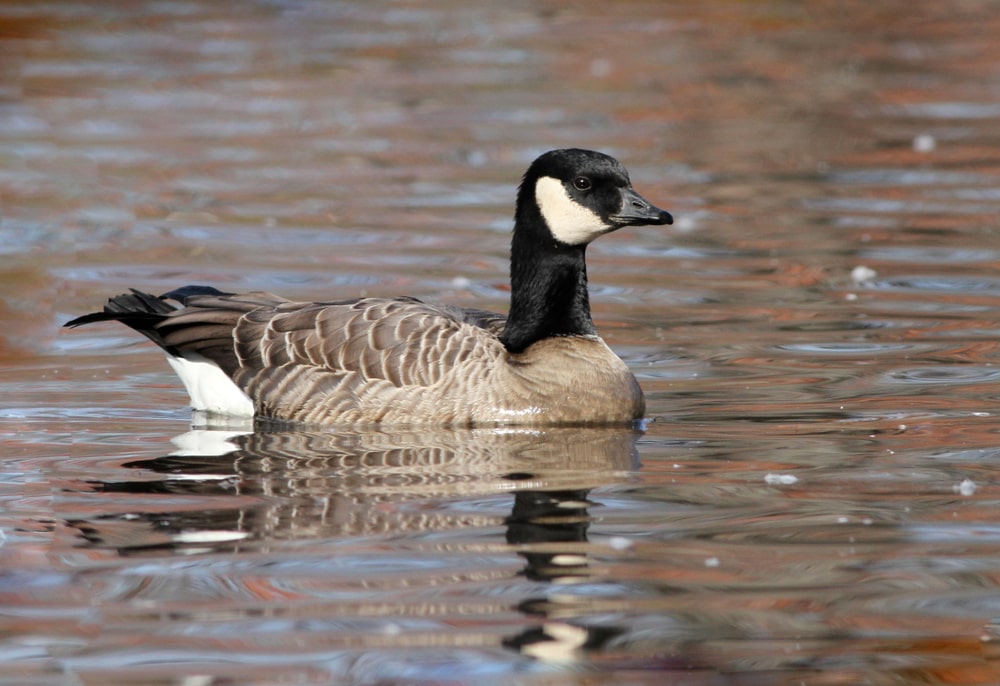
The cackling goose is almost identical in plumage to its Canadian relative. It wasn’t until 2004 that the cackling goose became its own species. In fact, they appear as a miniature version of the Canada goose.
They weigh only 3.1 to 5.3 lbs (1.4 to 2.4 kg) with a 42.5 to 43.5 inch (108 to 110.5 cm) wingspan.
There are two striking differences between Canada geese and cackling geese. Their bill is much stubbier than its Canadian relative. On the other hand, the wings appear much shorter in flight.
These geese were considered the same species for centuries for a reason. The two species mate for life, choosing one partner and one location for breeding every year. Only when one of the two dies will the other search for a new mate.
Like many species on the list, their diet consists of grasses and water rushes. During migration, their diet will change to grains and wheat from farms they fly over.
3. Snow Goose (Anser caerulescens)
The snow goose is a wild goose of North America. These waterfowl weigh between 3.5 and 7.3 lbs (1.6 and 3.3 kg) and have a wingspan of 53.4 inches (135.6 cm).
The adult snow goose comes in two color morphs, white and blue. These morphs are either an all snow-white body or a dark blue body with a white face.
Ornithologists first documented the blue morph in 1925. For years, they considered the blue goose to be a different species.
Genetic tests then revealed the blue goose was indeed a snow goose. They discovered the blue gene is slightly dominant over the snow one. Most times, goslings with white plumage can’t have parents with the blue morph.
Like many wild geese, the snow goose hatchlings enter the world very developed. Within a few weeks, goslings are capable of walking miles. They would then follow their parents to the foraging grounds.
The hatchlings are born with their color morph visible right away. The color morph makes identifying goslings very easy. The blue contrasts with the light gray molting and is unique to Snow and Ross’s geese.
4. Ross’s Goose (Anser rossii)
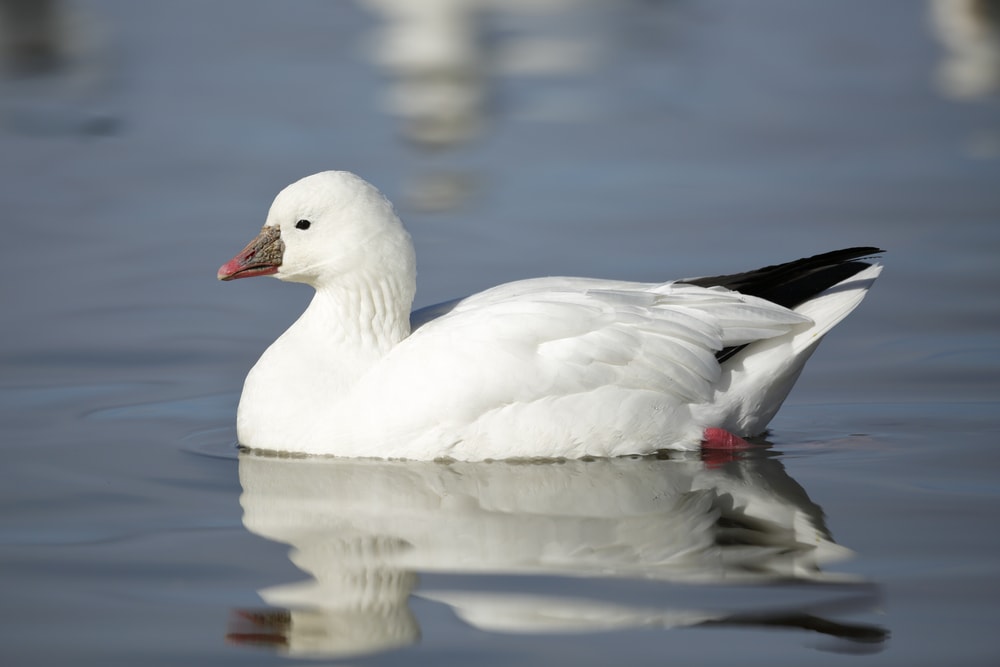
Ross’s goose is a compact relative of the snow goose. This species looks and behaves like snow geese, with a few unique characteristics. They weigh less, usually 2.6 to 3.4 lbs (1.2 to 1.5 kg), and have a 45-inch (114 cm) wingspan.
Ross’s geese have a similar range and migratory pattern to snow geese. Smaller groups will opt to travel with the giant snow geese flocks. Their plumage is very similar as well, but the white of a Ross’s appears far brighter.
Although they lack some of the stainings of a snow goose, there are rare times Ross’s goose will have a blue morph. Researchers first found the clue morph in 1979. This was when the range of Ross’s geese began to move eastward, closer to the snow goose.
Today, their ranges overlap frequently, and the consensus is this morph is a hybrid of the two species.
Many thought Ross’s geese to be endangered until the late 20th century. In recent years, Arctic warming has exposed more grassland for the geese to feed. The result has been a population boom, and now their conservation status is of least concern.
5. Barnacle Goose (Branta leucopsis)
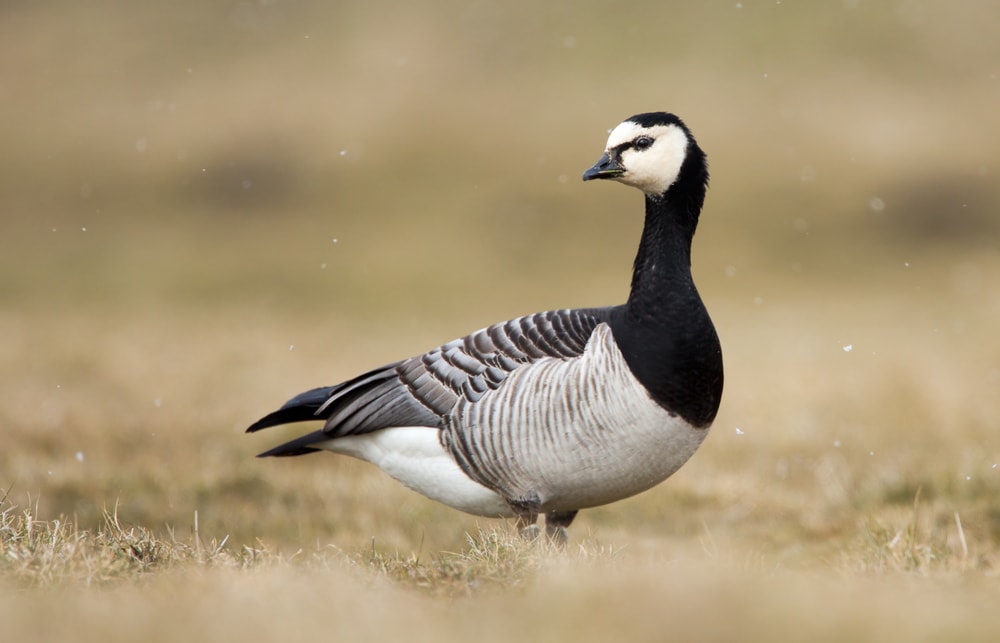
One of the smallest wild geese weighs 2.7 to 5 lbs (1.2 to 2.3 kg) and has a wingspan of 51 to 57 inches (130 to 145 cm).
Barnacle geese spend the breeding season and summer in the Arctic and Greenland. This is before moving to northwest Europe for the winter.
This goose is most well known for its one-of-a-kind breeding behavior. The barnacle goose nests on sheer mountain cliffs to avoid polar bears and Arctic foxes.
A few days after hatching, the young have to jump from incredible heights to the ground in pursuit of food. Their lightweight frame allows them to fall from impressive heights without harm.
Their name comes from an old legend. Back then, Europeans were confused about why these geese only appeared in winter. This led to speculation the geese were born of barnacles.
The barnacles would last the winter and birth these geese in the summer. Despite being proven false, the name stuck with the species.
6. Emperor Goose (Anser canagicus)
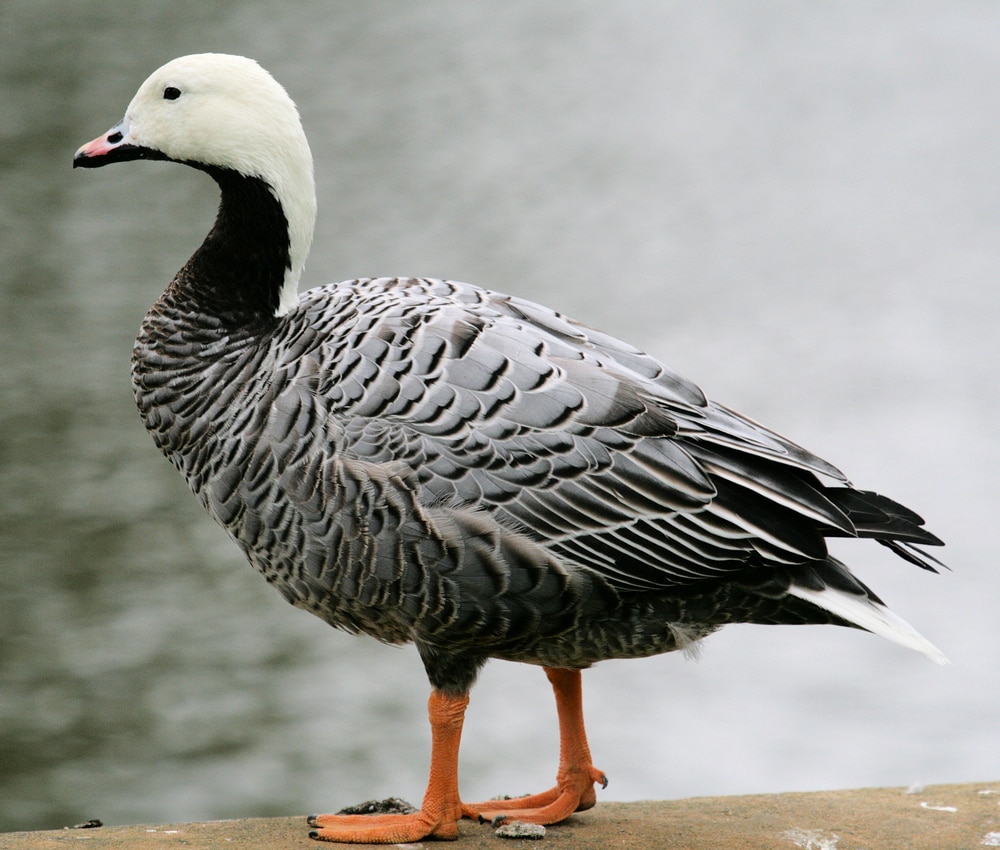
The emperor goose is a relative of the snow and Ross’s goose. It’s found only on the coastlines of Russia and Alaska that form the Bering Sea.
Emperor geese weigh 5 to 7 lbs (2.3 to 3.2 kg) and have a 48 to 56-inch (122 to 142 cm) wingspan.
The plumage is what truly defines this goose. The black-barred bodies contrast the bright white head and neck. The coloring gives the impression of a white crown, earning it the title of emperor.
Some emperor geese will have rusty stains on their white face. This is because the tidal pools they frequent in the summer are high in iron. During feeding season, these pools often leave them with a rust-orange hue on their face.
The most beautiful goose on the list has one of the smallest populations. With only an estimated 140,000 emperor geese in the wild, they are close to becoming a threatened species.
Hunters were allowed to harvest the geese a few years ago, which is the speculated cause of the decline. If numbers continue at the current trend, hunting this species will be prohibited.
7. Brant Goose (Branta bernicla)
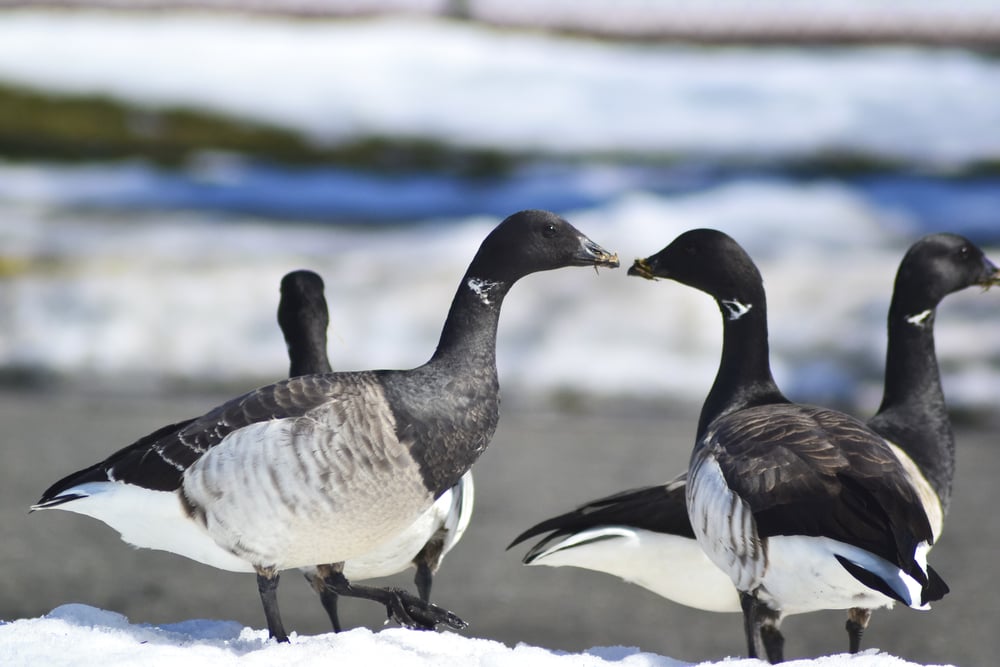
The brant goose’s migration pattern might make it the most ambitious on this list. Brants have been documented nesting farther north than any other goose. This is because they opt to migrate as far down as Baja or Florida.
A die-off of their favorite eelgrass in the 1930s pushed the species inland in search of food for many years. This habit has remained with some populations of the Brant goose. This drove them to travel as far east as central Virginia and New York in search of food.
A brant goose weighs 2.6 to 3.8 lbs (1.2 to 1.7 kg) and has a wingspan between 41.3 and 42.5 inches (105 and 108 cm).
They are the only North American goose with an all-black head and neck. The head appears boldly next to their brown-white bodies. They are considerably similar in color to Canadian geese.
The white ring on their neck tends to vary in size. One Canadian study revealed that partners shared a similar-sized ring on their necks.
8. Greater White-fronted Goose (Anser albifrons)
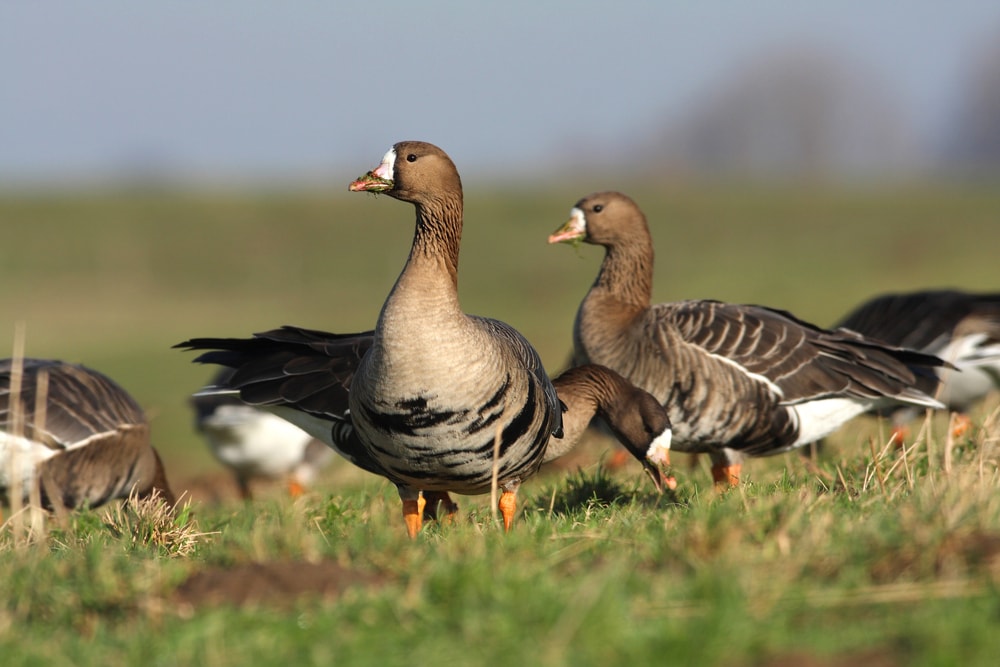
The greater white-fronted goose is native to North America and western Europe. These geese are separated into greater and lesser subspecies.
As the names imply, size is the primary differentiator. However, the two species do not occur together. Lessers are native to parts of Europe and Asia and have slightly different plumage.
Greater white-fronted geese weigh 4.3 to 7.3 lbs (1.9 to 3.3 kg) with a 53-inch (135 cm) wingspan.
They get their name from the white plumage around their pink-orange bills. The bodies of these geese are brown and have black bars marking their chest and belly.
Like most geese, the greater white-fronted choose mates for life. Uniquely, their family bonds appear to be stronger than other species.
It only takes a few months for the offspring to learn how to fly. Despite this, they still stay with their parents through the following breeding season.
Research also observed offspring returning to breed in groups with their parents. They maintain this parental bond later into adulthood than any other geese.
9. Red-breasted Goose (Branta ruficollis)
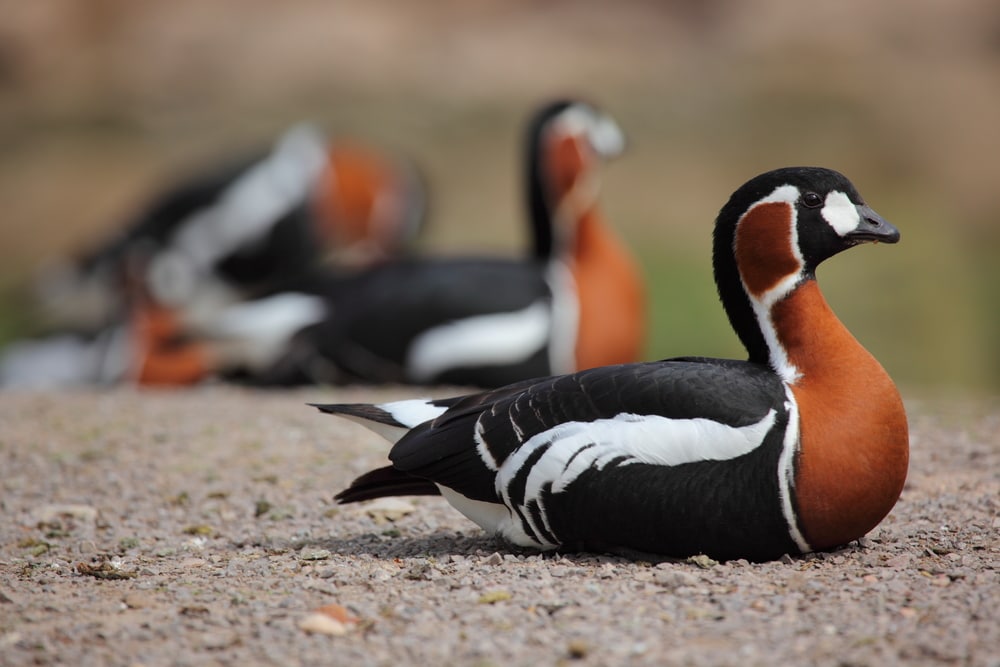
The red-breasted goose plumage stands apart from any other species. They bear black and white faces and reddish-brown markings. These characteristics make the goose one of the most visually appealing on the list.
These geese breed in Arctic Russia and winter along the coastline of the Black Sea. They are rarely spotted outside the harshest climates. However, their attractive plumage makes them frequent zoo residents.
Aside from appearance, the species was introduced to zoos to aid its conservation. This is due to their classification as a vulnerable species. Today, only less than 40,000 wild geese remain.
Hunting and oil rigging disturb the feeding grounds of the goose. With limited options and a harsh climate, these activities contributed to their decline.
10. Bean Goose (Anser fabalis)
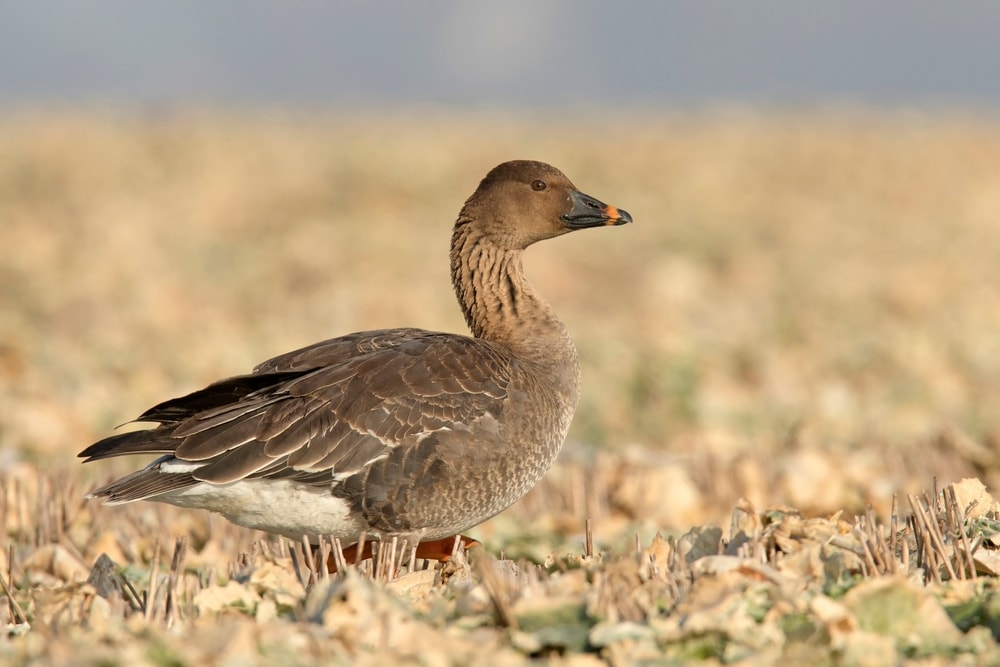
The bean goose is found across the northern regions of Europe and Asia. The bean goose breeds and spends most of the year from the northern reaches of Norway to Siberia. It isn’t until winter that these geese inhabit central Europe and Asia.
Bean geese typically weigh 3.3 t 8.8 lbs (1.7 to 4 kg) with a wingspan of 55 to 69 inches (140-174 cm).
The bean goose’s most noticeable feature is the orange stripe on its bill. Their feet are also bright orange compared to the pink shade of the similar pink-footed goose.
The bean goose has five recognized subspecies. Taiga bean geese have three classifications. Taiga signifies the species is home to coniferous forests.
The Tundra Bean geese have two additional subspecies. These subspecies are known for breeding in the Arctic tundra.
11. Pink-footed Goose (Anser brachyrhynchus)
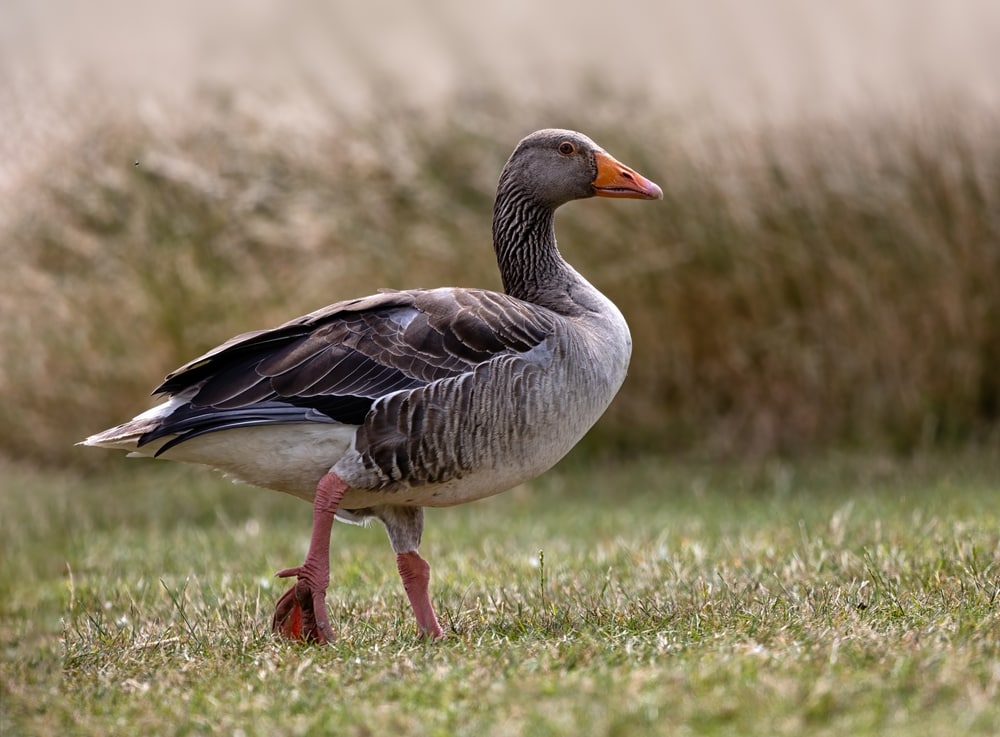
Similar to bean geese, pink-footed geese are wild geese found across Europe. The birds breed and nest in Greenland and Iceland. Afterward, they move to mainland Europe for the winter.
Pink-footed geese get their name from their bubblegum pink feet. Their bills are also a clear identifying trait. Compared to its greylag and bean goose relatives, their bills are much smaller.
Pink-footed geese weigh 4 to 7.5 lbs (1.8 to 3.4 kg) and have a wingspan between 53 and 67 inches (125 and 170 cm).
Pink-footed geese, like many Arctic foragers, have a large carbon footprint. When they feed on grasses during a thaw, a large amount of carbon is released into the atmosphere.
12. Egyptian Goose (Alopochen aegyptiaca)
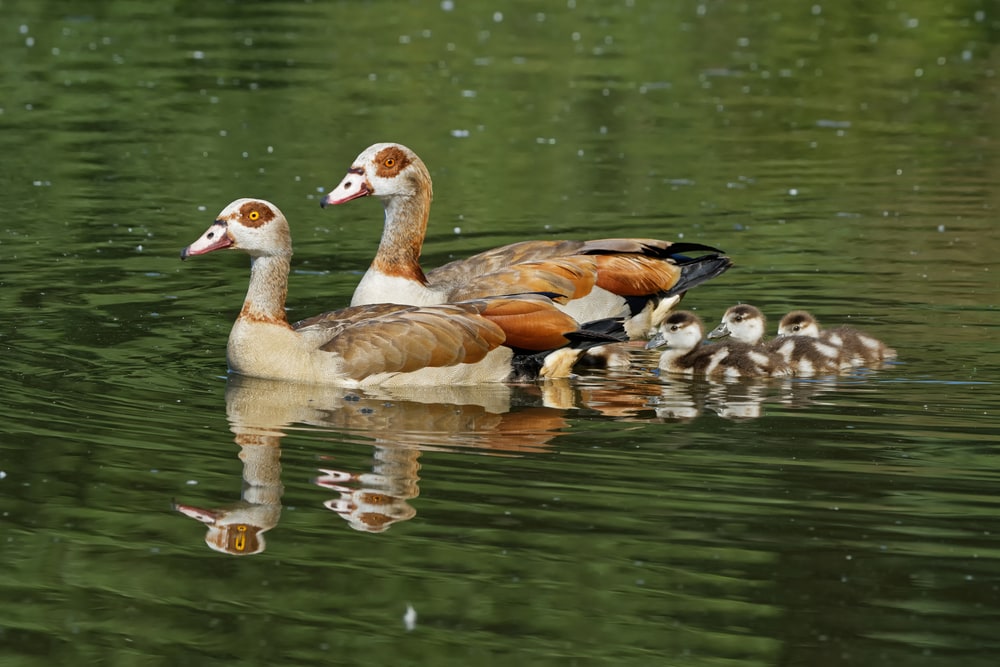
The Egyptian goose is one of the more beautiful geese in the world. Despite being genetically closer to a shellduck, the bird is classified as a goose. Egyptian geese are more like ducks in their ability to swim. But they seem to be more lumbering and goose-like when in flight.
Males and females are similar in appearance, with females tending to weigh less. The Egyptian goose is one of the smallest in the world, weighing only 3.3 to 5.3 lbs (1.5 to 2.4 kg).
The goose is native to the Nile River delta and found outside the desert in many parts of Africa. Egyptian geese are common in zoo and aviary exhibits.
In warmer climates, escaped geese are capable of establishing a wild population. Such places include the southern United States.
Egyptian royalty prized the Egyptian goose as an ornamental bird. There is evidence of the goose in tomb paintings thousands of years old. Research also uncovered these birds were used as livestock and pets for centuries.
13. Greylag Goose (Anser anser)
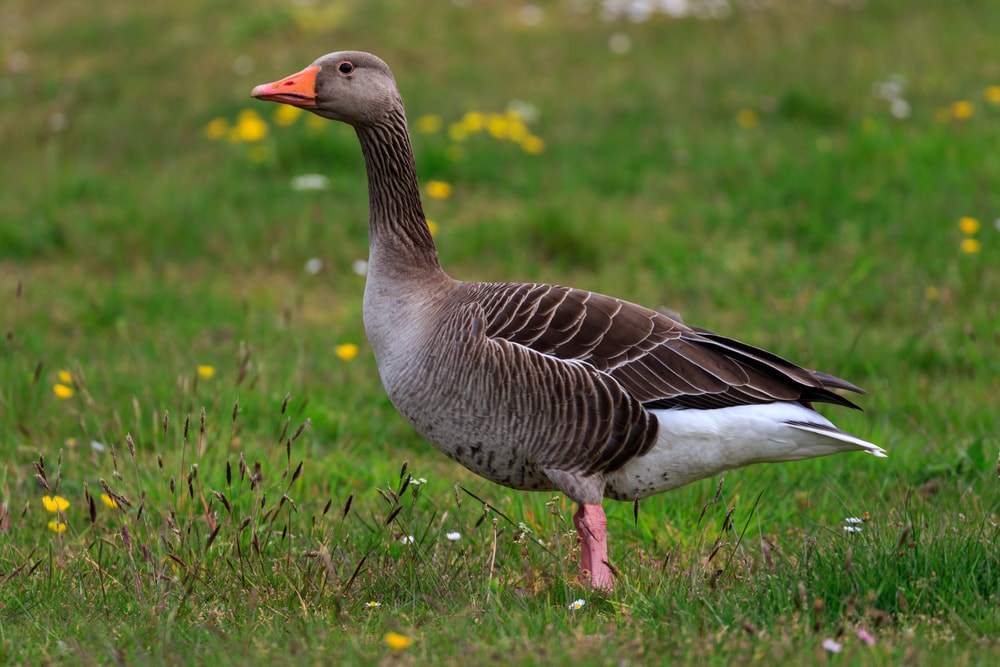
Greylags are the ancestor of most species of domestic geese alive today. They’re also the most substantial goose found in Europe and Asia. Any goose with the biological name anser tends to have some genetic link to the greylag.
These geese weigh 6.4 to 8.2 lbs (2.9 to 3.7 kg) with a wingspan between 57.9 and 70.9 inches (147 and 180cm). This makes them a practical choice for meat production.
The history of their domestication is still a mystery. This is perhaps because geese are not as pervasive as domesticated chickens. But as far back as the Egyptian empires, there are records of raising geese for meat, eggs, and feathers.
In earlier times, wild populations originally wintered in Europe. It’s possible that past hunters and farmers were able to capture breeding pairs.
With a great capacity for fat storage, farmers would overfeed them to the point they couldn’t fly. This may be what began the species’ domestication.
14. American Buff Goose
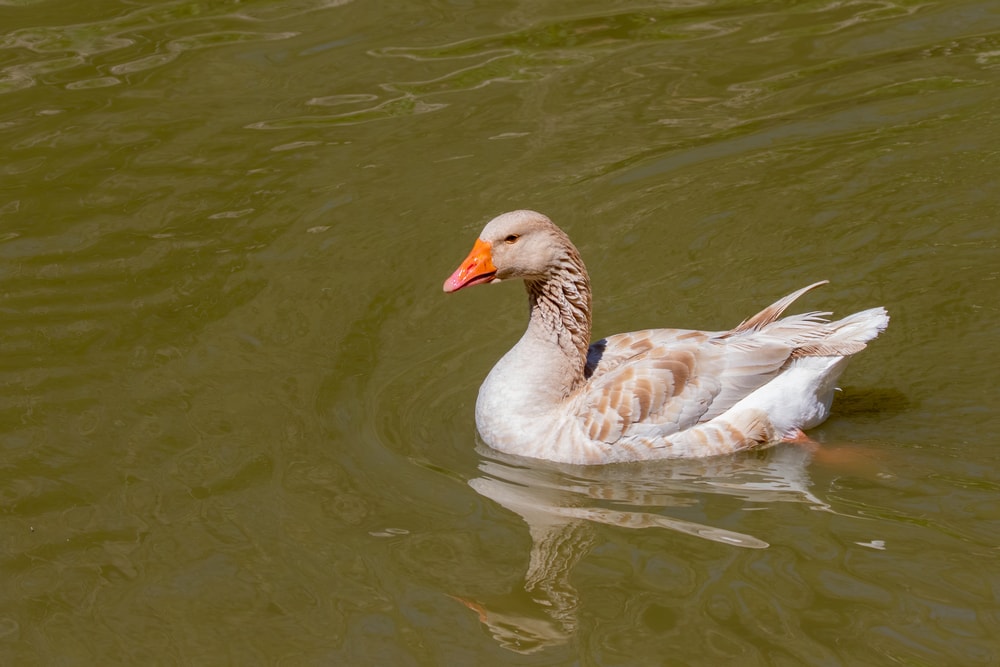
American buff geese are one of two domestic geese species natively bred in the United States.
No one quite knows how we got the American buff goose. Its genes tell us it is a descendant of the greylag. However, there is no documentation of selective breeding. It’s believed to be a hybridization that occurred naturally and quickly domesticated.
Their plumage is what sets them apart from any other domesticated goose. While most are brown, white, or black, the American buff has an apricot color to its feathers.
Today, the species’ conservation status is listed as critical. There are less than 500 breeding geese left in the United States. Most small farmers use them for egg production or meat in rare cases where they have breeding pairs.
15. Pilgrim Goose
The pilgrim goose is the second species of domestic goose from the United States. Today, it’s mainly used for egg production in the US and the UK.
An adult pilgrim goose weighs 12 to16 lbs (5.4 to 7.3 kg) and forages on grasses and grain on the farm.
This species has two unique characteristics, unlike most domestic geese. Their temperament is unlike most species, and they rarely honk or call. Farmers also find them to be friendly, docile animals to keep.
Pilgrim geese are also only one of four domestic species with sexual dimorphism. This is when the male is distinguishable from the female through their appearance. Upon hatching, male bills are noticeably brighter. The male’s all-white plumage then shows after two weeks.
This goose is listed as critically-endangered in the United States. This is despite there being no current breeding population available.
Rather than meat production, geese are used more for egg production. One goose is capable of laying 50 eggs per breeding season.
16. Swan Goose (Anser cygnoides)
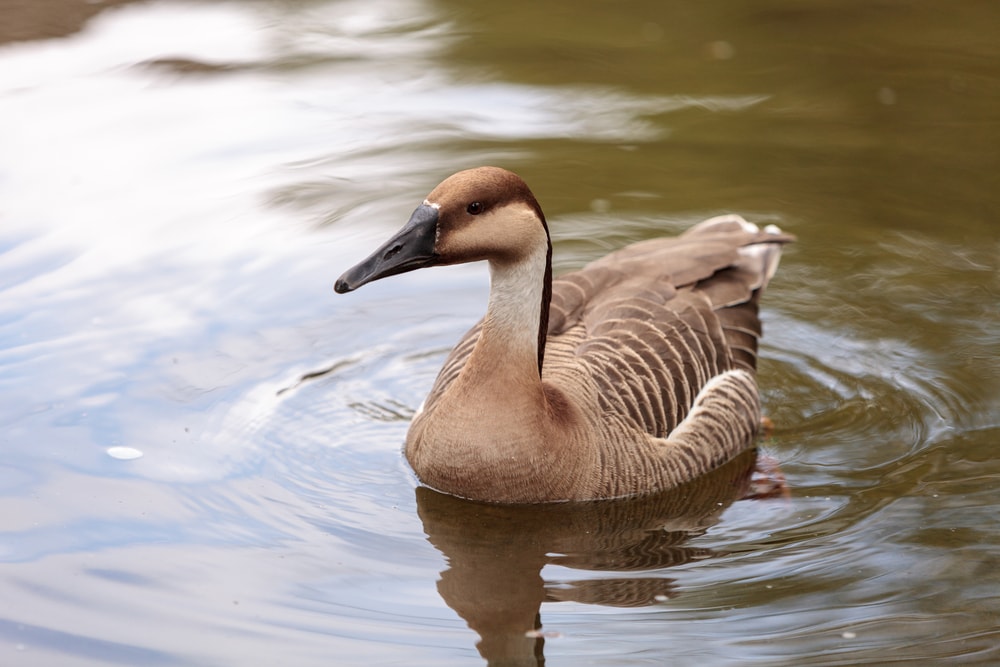
The swan goose, like the greylag, is a direct ancestor of many geese species. It is the origin point for over 20 subspecies of Chinese geese. All subspecies are called knob geese for the bump on top of their bill.
It is the second largest of the Anser geese occurring in the wild. They typically weigh between 6.2 to 7.7 lbs (2.8 to 3.5 kg).
The swan goose still maintains a small wild population today. However, most known breeding pairs are domesticated. These geese also rarely opt to swim, making them a prime candidate for domestication back in the day.
17. Chinese Goose
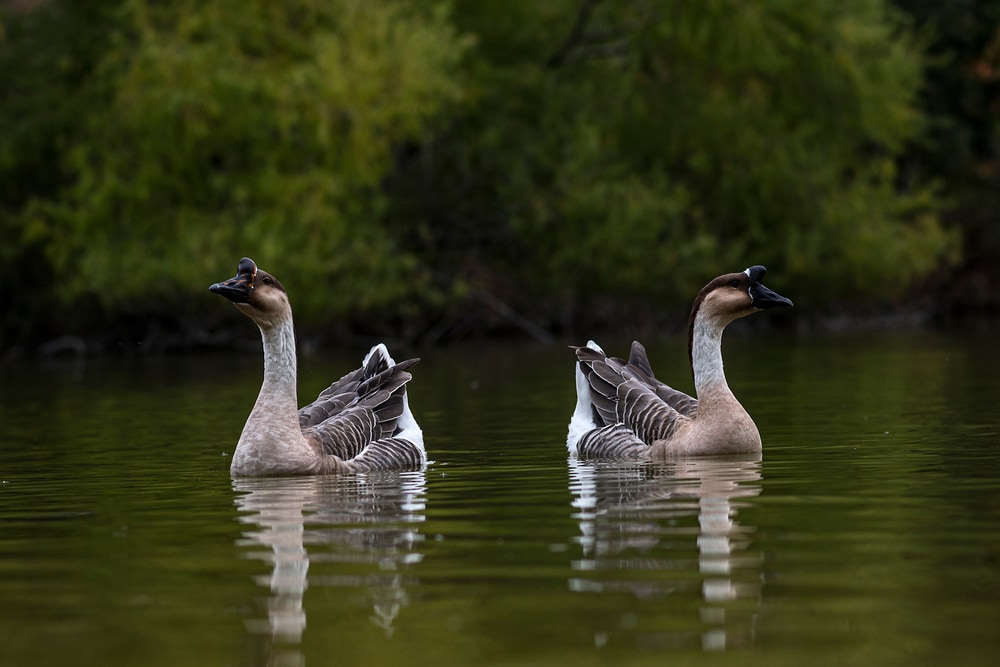
One of the more well-known descendants of the swan goose is the Chinese goose. Their plumage comes in either brown or grey, and their bills have a dark rich shade of brown.
The Chinese goose gets mistaken as a relative of the swan because of their elegant necks. Their necks are longer than other species but lack the S-shaped curve that defines a swan’s neck.
Also, like any goose, they’re too small to be a swan. Most swans weigh 20 to 30 lbs compared to 7.7 to 11.9 lbs (3.5 to 5.3 kg) for this species.
This breed is sought chiefly for its egg-laying ability. Chinese geese are the most prolific of any goose species and can lay up to 100 eggs in one season. With a good environment, ganders can produce dozens of potential offspring annually.
18. African Goose (Anser anser domesticus)
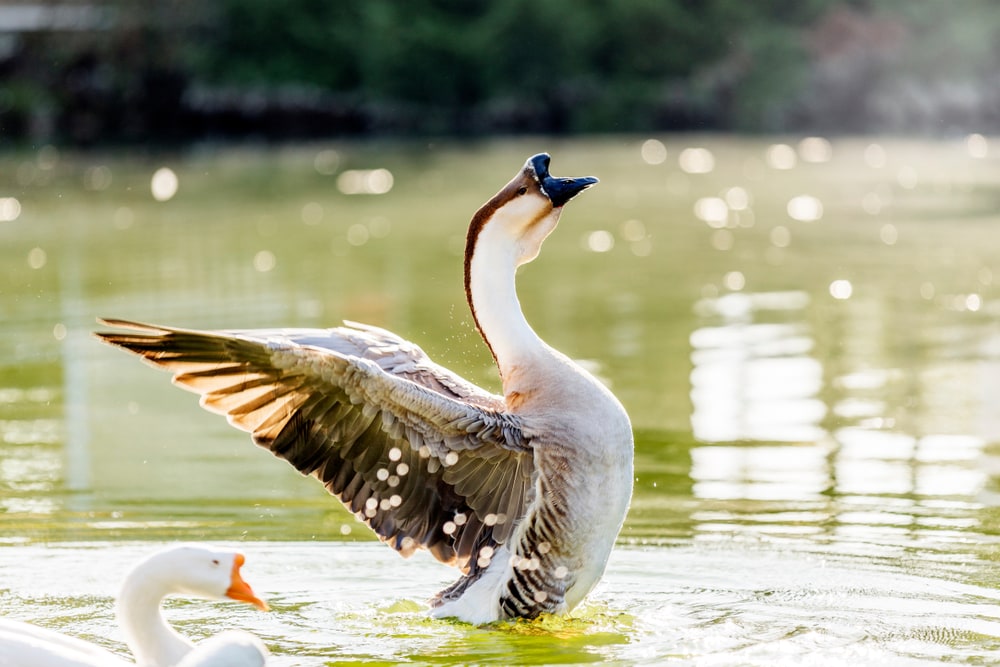
African geese are the physically imposing descendants of the swan goose. They are brown and gray in color and have a noticeable knob on their forehead.
This species is closest to the Chinese goose. In fact, the African goose’s dewlap and forehead knob differ from its relatives. These geese weigh 18 to 22 lbs (8.2 to 10 kg) with an average wingspan of 15 in (38 cm).
The bird’s name has nothing to do with its origin. In fact, it lacks any documentation regarding where it was first bred. However, it’s speculated that it was developed alongside the Chinese goose.
19. Sebastopol Goose
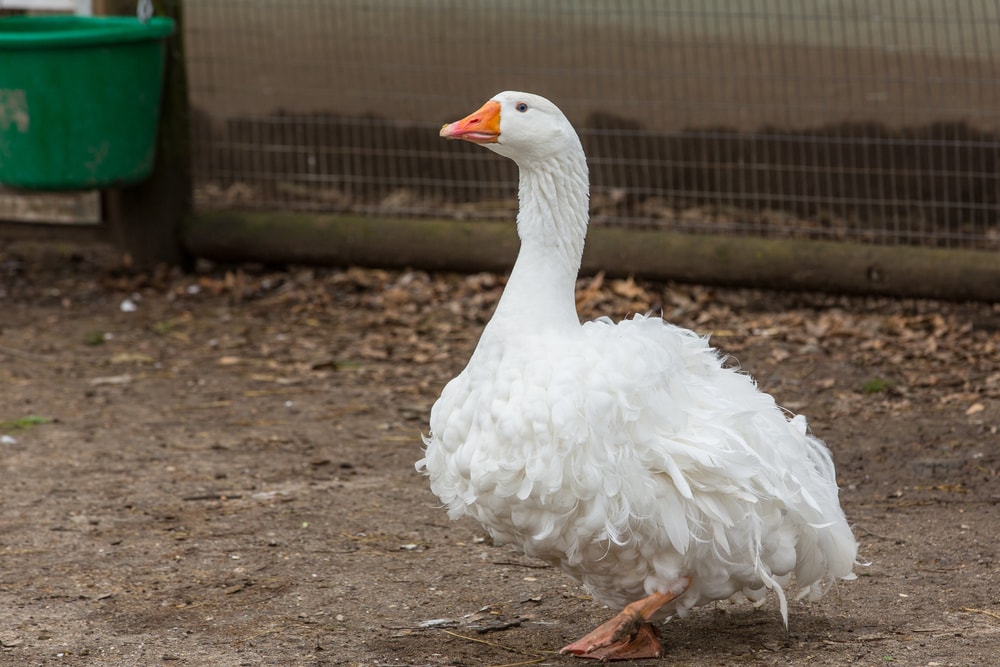
Sebastopol geese are draped in a white, flowing coat of feathers unlike any bird on the list. Their feathers make it so they can’t even fly. The whispy curls and extra weight make it impossible for them to get any air.
They are an obvious visual example of a species being bred for a specific purpose. Sebastopol geese only tend to weigh 10 to 14 lbs (4.5 to 6.4 kg), making them much smaller than most domestic species. However, they produce elaborate plumage and are most often an ornamental species.
The Sebastopol goose was originally bred along the shores of the Black Sea in Russia. Named for the port, Sebastopovol farmers defeather these geese. Their plumage would then be used in quilts, pillows, and jackets.
20. Pomeranian Goose
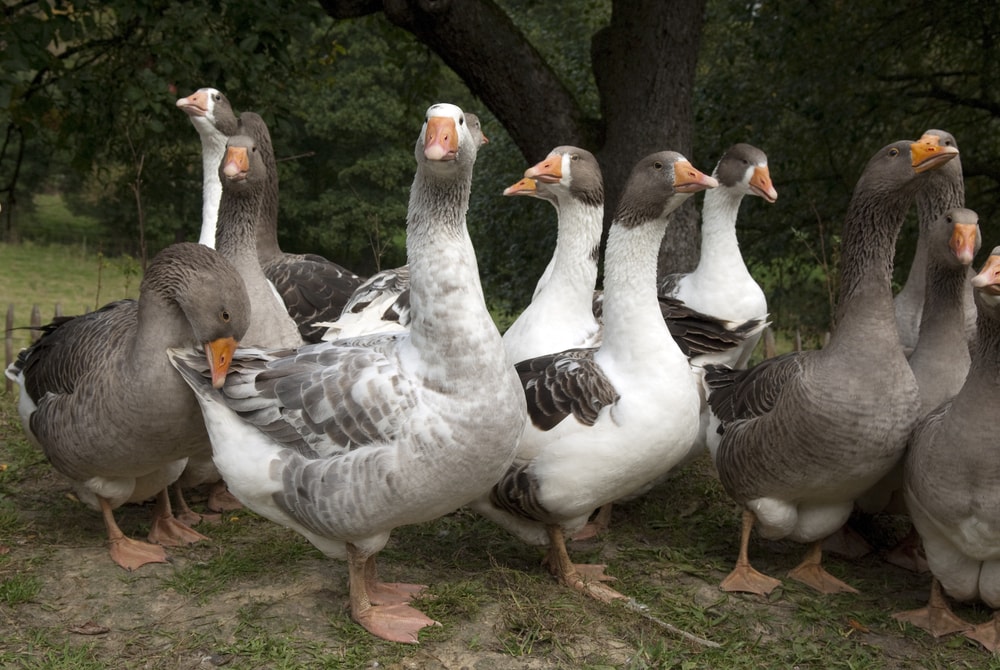
The Pomeranian goose is a heavy goose from Northern Germany as early as 1550. This domestic species weighs between 14 and 20 lbs (6.4 and 9.1 kg).
This species was bred with commercial production in mind. Its breast is larger than most and can lay around 100 eggs per season.
In addition to being prized for their production, this goose species is extra chatty. It makes them an effective alarm system for any unwanted visitors.
For many years, this goose was the most popular in markets. This was the case in countries like Germany, the Czech Republic, and Austria.
Today, few true Pomeranians are bred outside of Germany. The Pomeranian species seen and sold today are often of the saddleback variety.
21. Steinbacher Goose
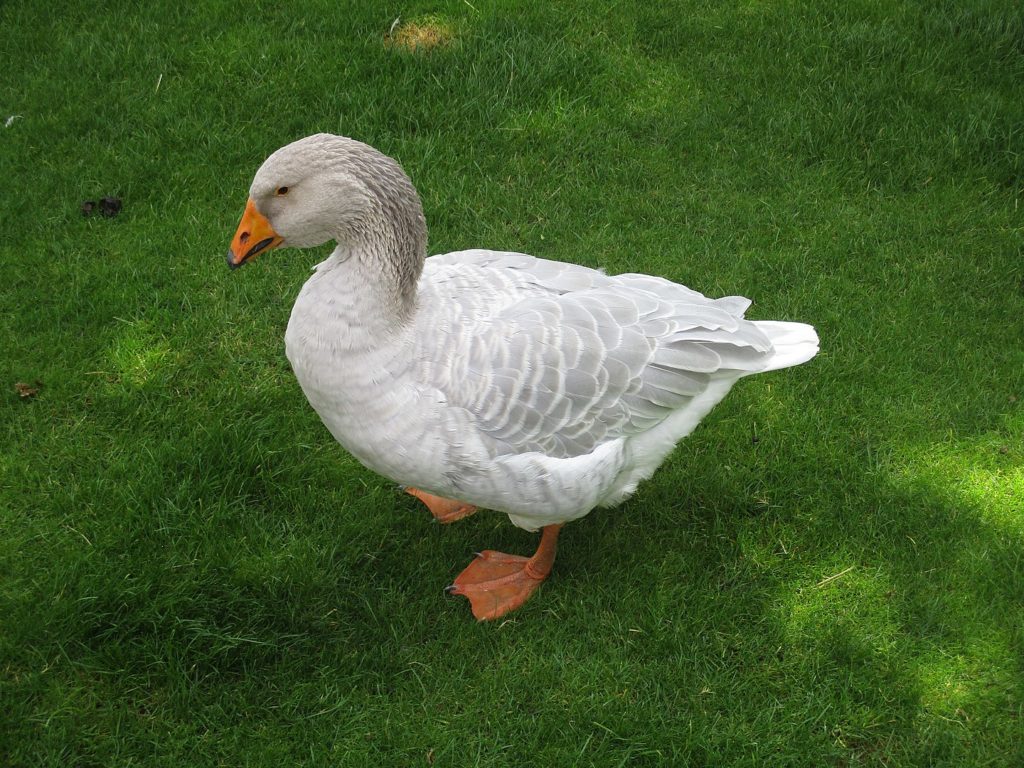
Initially bred in Germany, the Steinbacher goose also has a unique origin story.
In fact, this species was first bred as a fighting goose. Research points to breeders crossing a native goose with a Russian fighting goose. Their fighting days are long past them, however. Today, breeds are often regarded for their mild temperament.
The appearance of these birds makes them a sought-after species as well. A regular Steinbacher can weigh 11 to 16 lbs (4.9 to 7.3 kg). Their most notable feather is the black lipstick lining the serrations of the bill.
22. Czech Goose
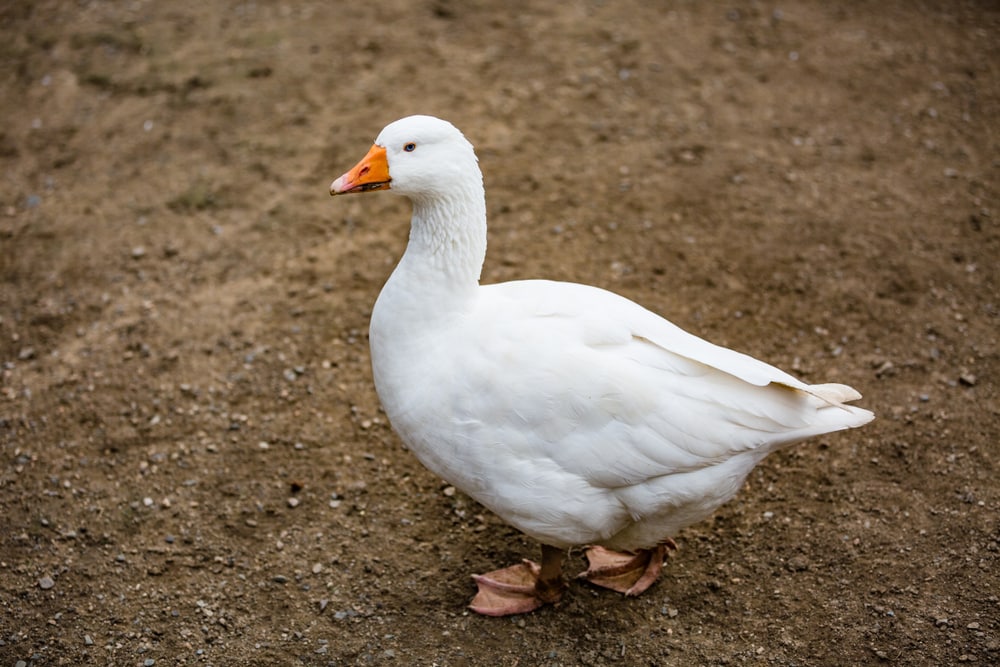
The Czech goose is another species with German origins. In fact, it is the most widely used waterfowl.
Czech geese are most similar to the Roman goose and have a tufted and classic breed. Their plumage is all white with a bright orange bill. They are of similar size, too. On average, Czech geese weigh 8.8 to 12.3 lbs (4 to 5.6 kg).
This goose was a vital member of small farms in the region for years. The Czech goose provides meat and eggs at a rate similar to most species.
This species also has a higher feather-to-down ratio. This makes Czech goose feathers popular for stuffing.
23. Toulouse Goose
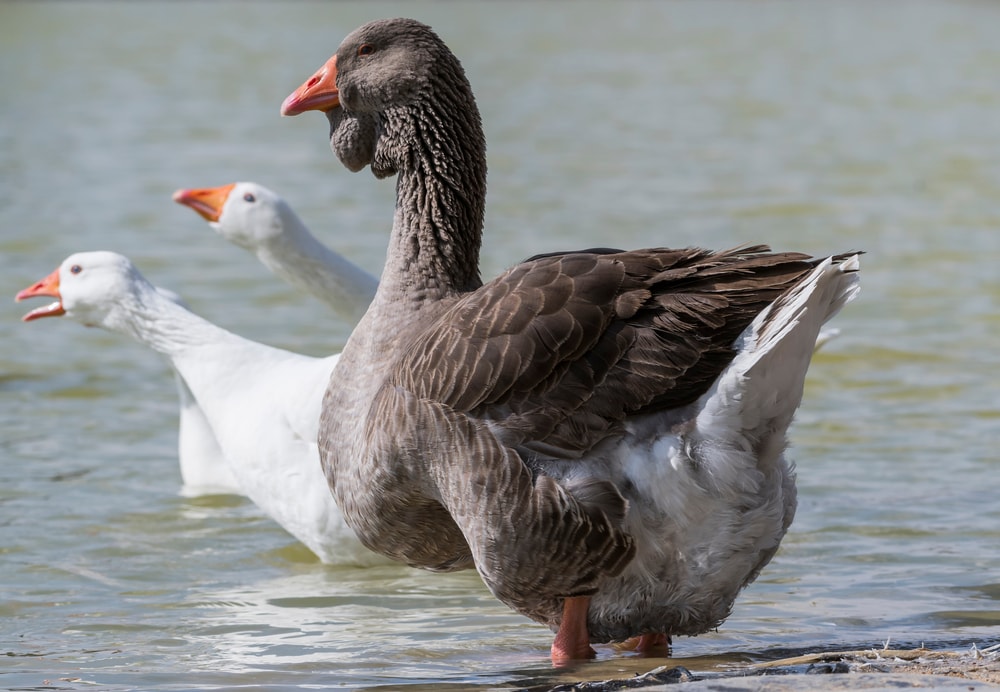
The Toulouse goose is named for the southwest region of France from where they came. They also have two recognized variations. One type of Toulouse goose has a dewlap and is slightly larger, while the others do not.
All Toulouse geese weigh between 15 and 20 lbs (6.8 and 9.1 kg). The dewlap serves no biological function for the geese and is a result of breeding efforts in the 1800s.
In the 1800s, ships brought these geese to the UK. Breeders then quickly started producing a much larger Toulouse goose. The trend continues today, with geese from the US and UK weighing more in the 18 to 20 lbs range.
Toulouse geese are rather popular among American farmers. This is thanks to its ability to withstand the harsh Midwest winters. With a healthy population, the goose continues to be used for egg and meat production.
24. Landes Goose
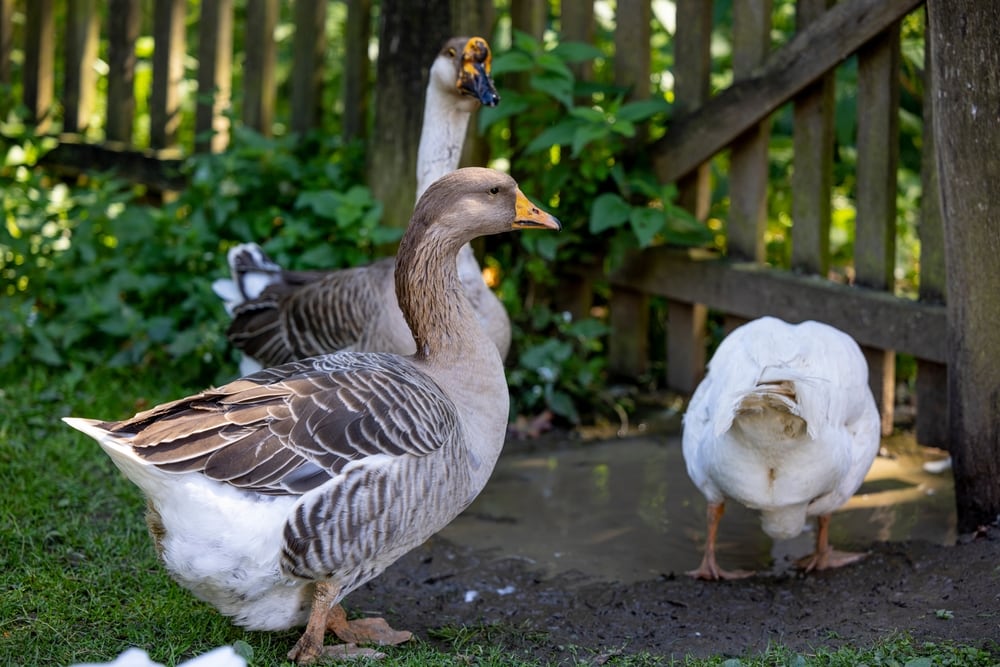
The Landes goose was another goose developed in the South of France around the time of the Toulouse.
Despite this, these geese physically differ from the Toulouse. The Landes geese’s most noticeable feature is their double stomach pouch. You will also never see a Landes goose with a dewlap.
They are a smaller breed and weigh (5.5 to 7.3 kg) when fully grown. Landes geese bills are a simple orange, too.
This smaller size limits its use in commercial meat production. Interestingly, the French first bred the Landes goose for its high-quality liver meat.
Foie gras is considered a delicacy in French cuisine and consists of fatty goose liver. To obtain the ideal cut of liver, a Landes goose needs to be force-fed grains to fatten it up before production.
25. Emden Goose
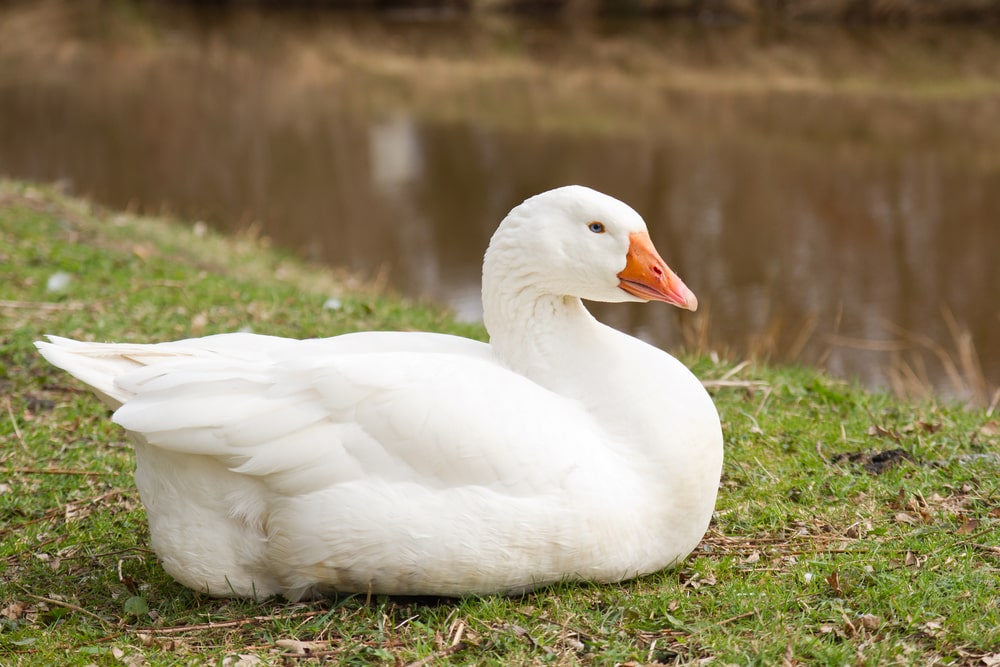
The Emden or Embden goose is prized worldwide for its size and heartiness. This goose’s name is based on a town in the northwestern area of Germany.
Americans then brought the geese over for their ability to withstand the winters. In America, they are also named Bremen geese.
Full-grown Emden geese can grow over 25 lbs (11.3 kg). Their size makes them popular candidates for meat production. This bird only takes two to three years to reach maturity, allowing for faster turnover.
The geese also serve as weed control in many small-scale farms. Emdens are expert foragers; it only takes a few to control weeds effectively.
26. Tufted Roman Goose
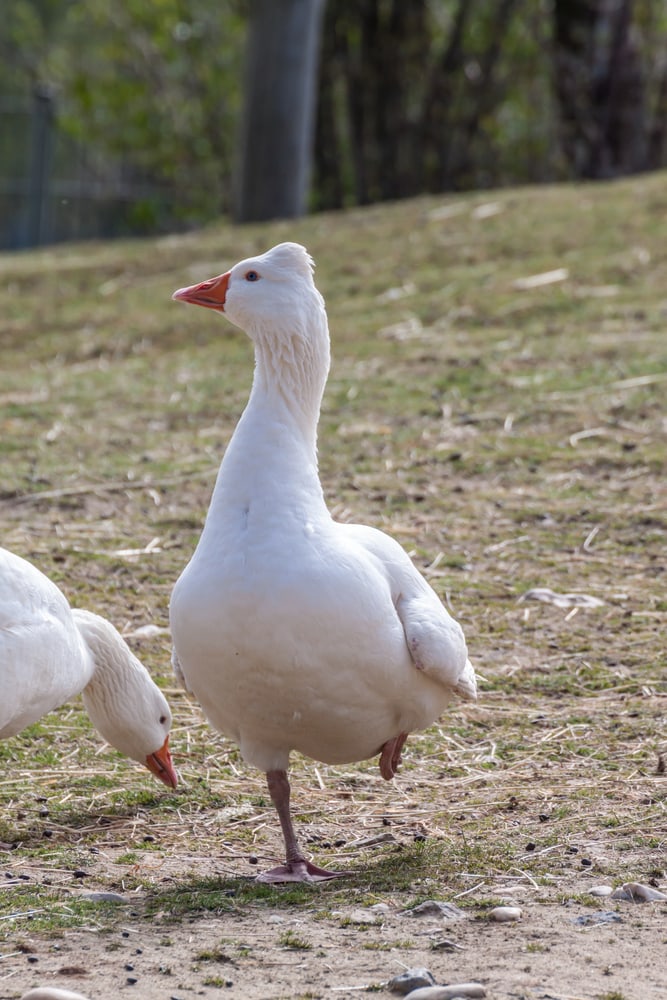
The tufted Roman goose is the more famous relative of the classic Roman goose. It gets its name from the little white crown of feathers tufted on the back of their heads.
These smaller geese only weigh 10 to 12 lbs (4.5 to 5.4 kg). Despite their size, they were prized across Europe for centuries for their meat.
Tufted Roman geese are one of the oldest species alive today, dating back over 2,000 years to the Roman era.
These beautiful birds have bright white plumage with a striking orange bill. They are the only species with a tuft on their head.
In the Americas, tufted Romans entered best-in-show contests. These are competitions in which a goose’s beauty is judged.
Since the goose hails from Italy originally, the genetic pool in the United States is scarce. The Livestock Conservancy advises consumers to be mindful when selecting a breeder. This is due to congenital disabilities being shared among American-bred Romans.



